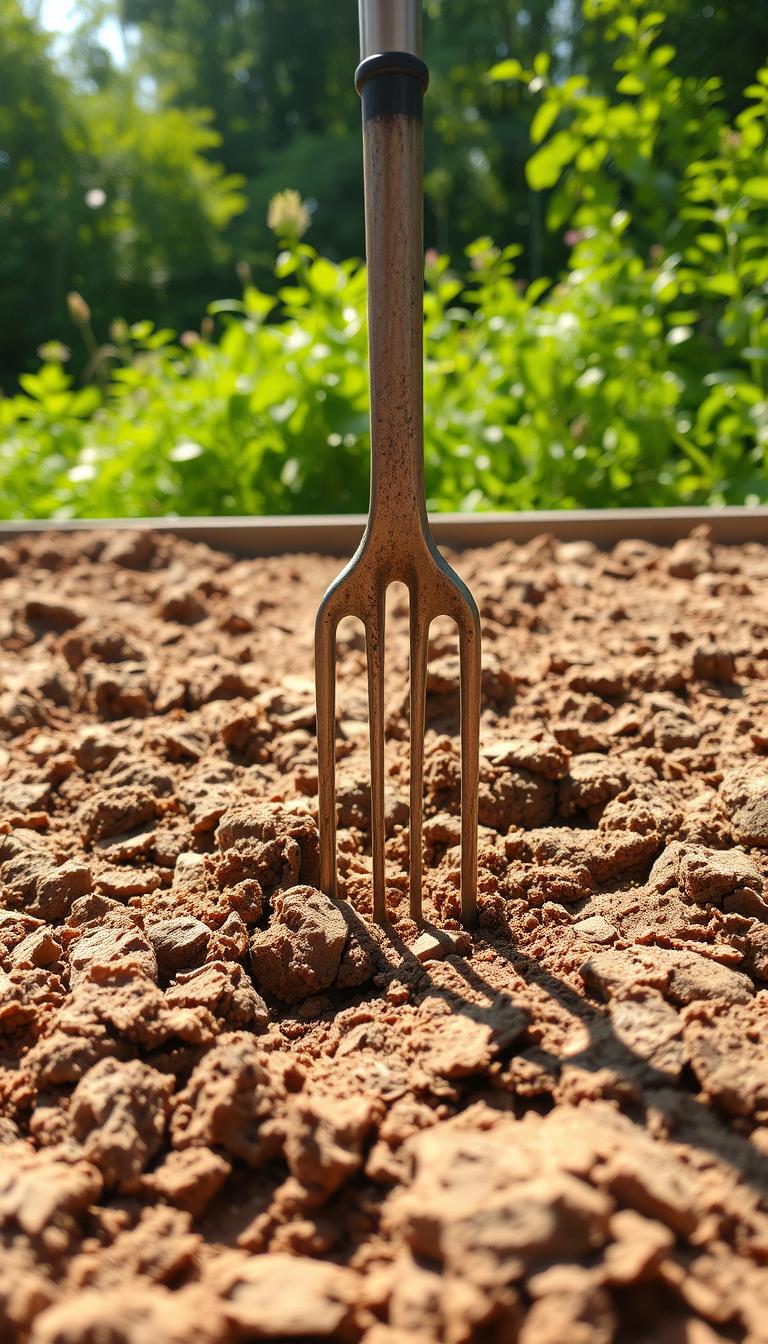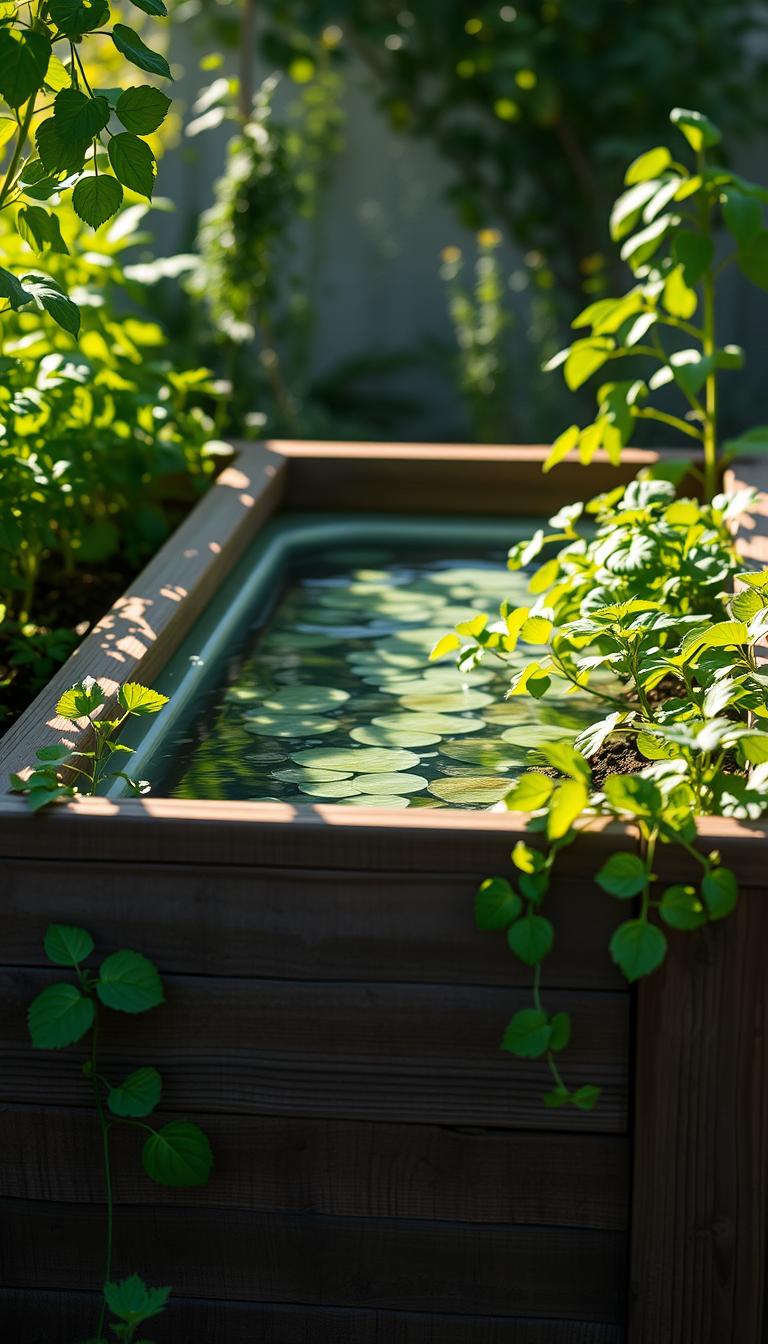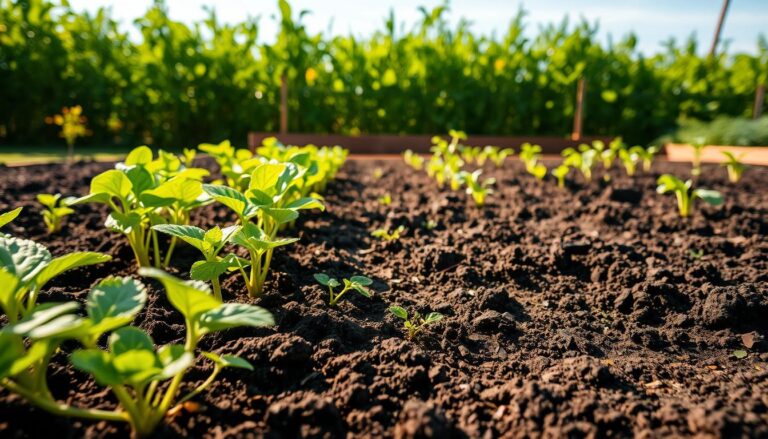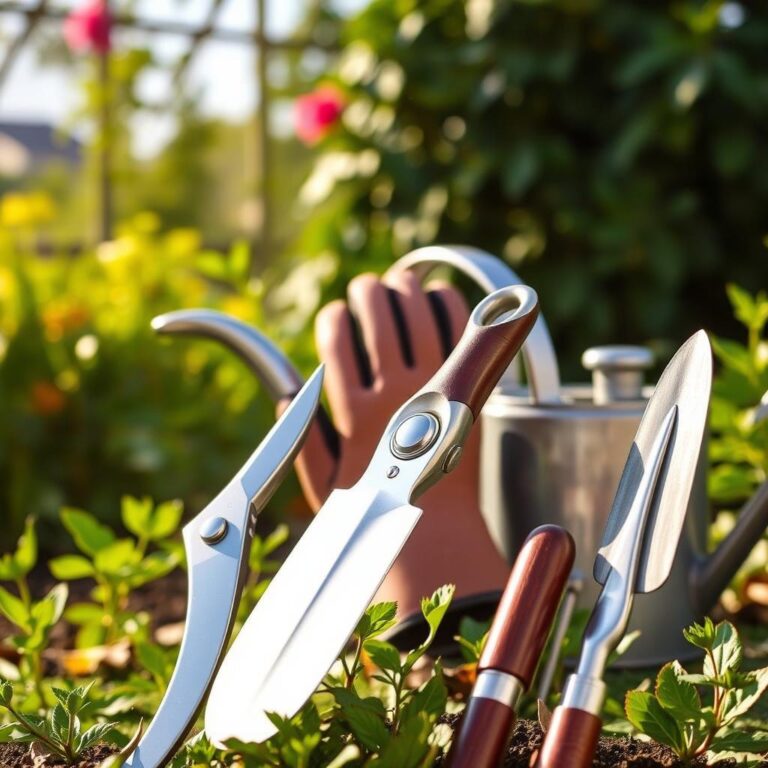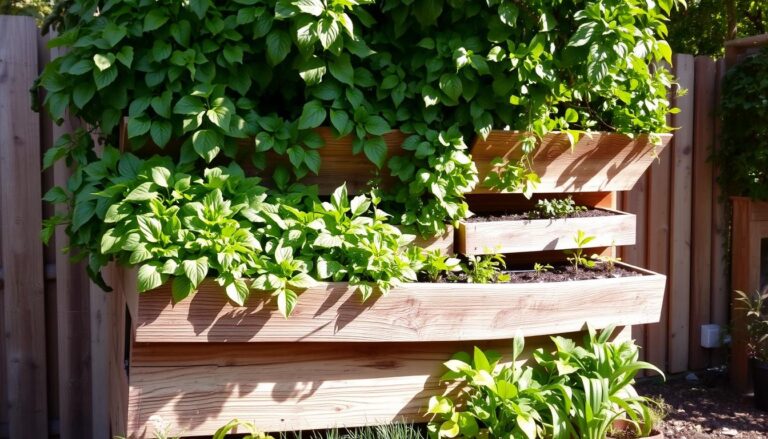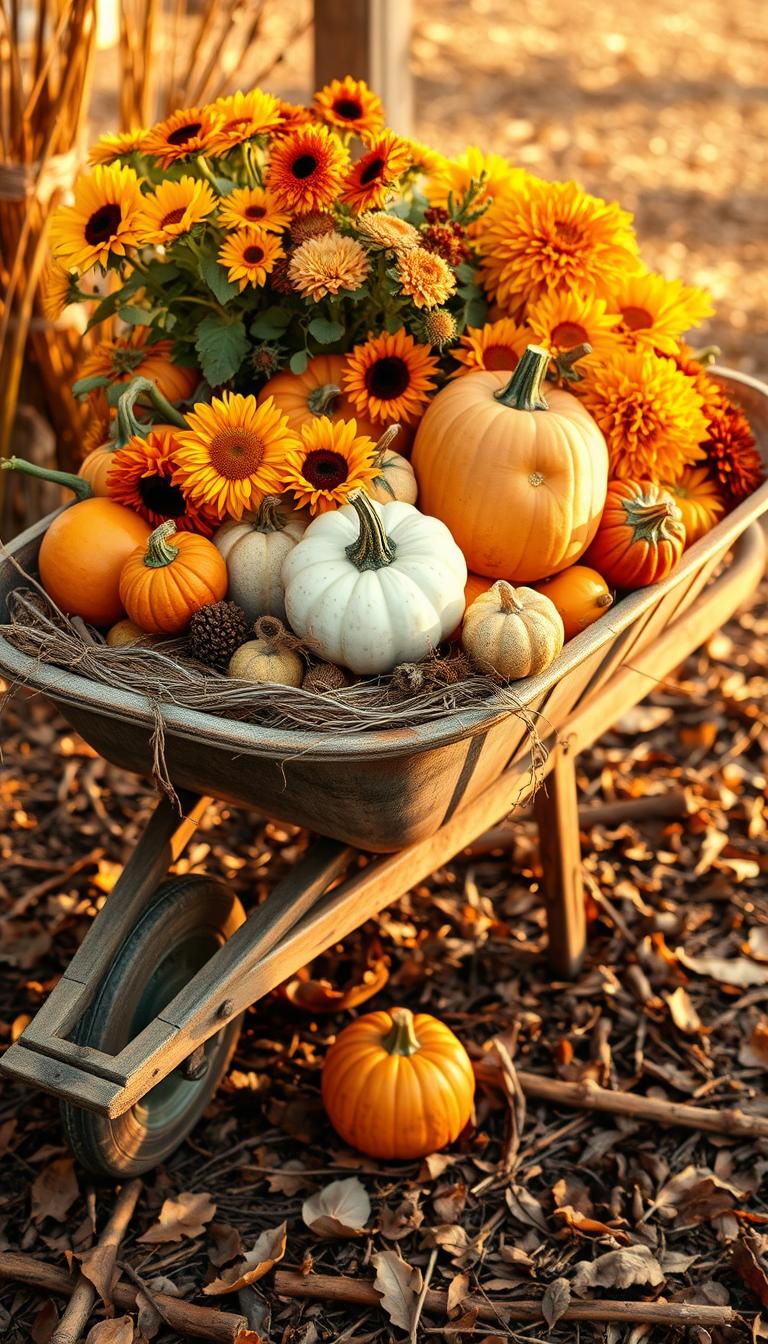Soil for Garden Beds: What You Need to Know
Have you ever planted seeds with excitement, only to watch them struggle? I remember my first attempt at growing tomatoes. The leaves turned yellow, and the fruits stayed small—no matter how much I watered them. A neighbor finally asked, “What’s in your raised beds?” Turns out, I’d overlooked the most important factor: the foundation beneath my plants.
Healthy growth starts with what’s underneath. In raised beds, the right blend acts like a life support system. It holds moisture during dry spells and drains well after heavy rains. Without balanced nutrients, even vigorous varieties become weak. Roots suffocate in dense material, while sandy textures let water slip away too fast.
Experts agree: testing your base is non-negotiable. A simple pH check reveals imbalances, and adding compost can transform lifeless dirt into thriving ecosystems. Over time, poor choices lead to pests, diseases, or stunted harvests—problems that cost more effort to fix than prevent.
This guide walks you through selecting, preparing, and maintaining the ideal environment for your plants. You’ll learn how to create mixes that retain moisture without drowning roots, boost fertility naturally, and avoid common pitfalls. Let’s dig deeper into building a base where every seed can flourish.
Table of Contents
Introduction: The Importance of Quality Soil for Garden Beds
Your garden’s success story is written in the quality of its underground ecosystem. Plants rely on this hidden network for water retention, nutrient access, and stable root development. Without balanced components, even vigorous varieties struggle to thrive.
Topsoil forms the foundation, supplying minerals and structure. Organic matter like compost introduces beneficial microbes while improving drainage. Together, these elements create air pockets that let roots breathe and expand. A depth of 12 inches allows most vegetables to anchor securely.
Consider these critical components in a productive blend:
| Component | Role | Benefit |
|---|---|---|
| Topsoil | Mineral base | Supports root structure |
| Compost | Nutrient source | Boosts microbial activity |
| Peat Moss | Moisture control | Prevents compaction |
Texture matters as much as ingredients. Sandy mediums drain too quickly, while clay-heavy ones suffocate roots. Test pH levels annually—most crops prefer slightly acidic conditions (6.0–6.8). Adding organic matter adjusts acidity naturally.
Raised beds benefit from layered mixes that mimic natural ecosystems. This approach ensures consistent moisture and reduces pest risks. Over time, a well-crafted blend becomes richer, yielding healthier plants season after season.
Understanding Garden Soil Fundamentals
Imagine your plants’ roots as tiny explorers navigating an underground world. This hidden realm determines whether they thrive or merely survive. Three elements shape this ecosystem: structure, composition, and balance.
Breaking Down the Building Blocks
Healthy growing mediums contain three core components:
- Minerals (like clay or sand) provide physical support
- Organic materials feed microbial life
- Living organisms recycle nutrients
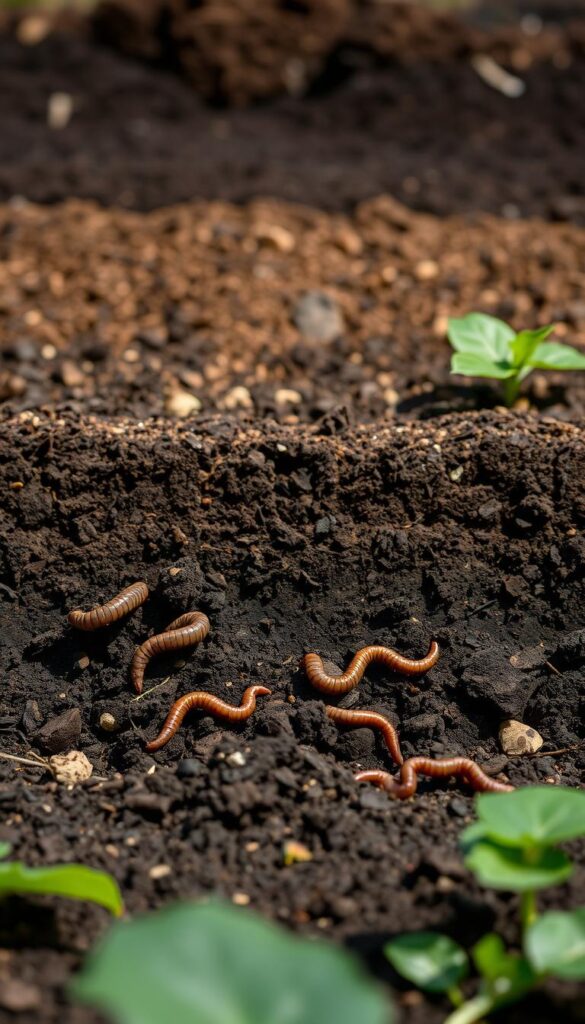
Clay particles hold moisture but can compact easily. Sandy textures drain faster than a sieve. The ideal blend? A loamy mix that retains water long enough for roots to drink deeply without drowning.
The Life-Giving Trio: Water, Air, Nutrients
Roots need oxygen as much as they need hydration. Compacted layers starve them of both. When organic matter decomposes, it creates air pockets and releases nitrogen, phosphorus, and potassium.
Consider this balance:
| Element | Impact | Optimal Level |
|---|---|---|
| Water | Dissolves nutrients | Moist but not soggy |
| Air | Supports microbes | 25% pore space |
| Nutrients | Fuels growth | pH 6.0–6.8 |
Add compost annually to maintain this equilibrium. Earthworms will move in, naturally aerating your mix and boosting fertility. Watch leaves perk up as roots access what they need—when they need it.
Key Characteristics of Ideal Garden Soil
What does productive earth feel like in your hands? Squeeze a handful—it should hold shape briefly before crumbling, like moist chocolate cake. This tactile test reveals more than you might think about your growing medium’s potential.
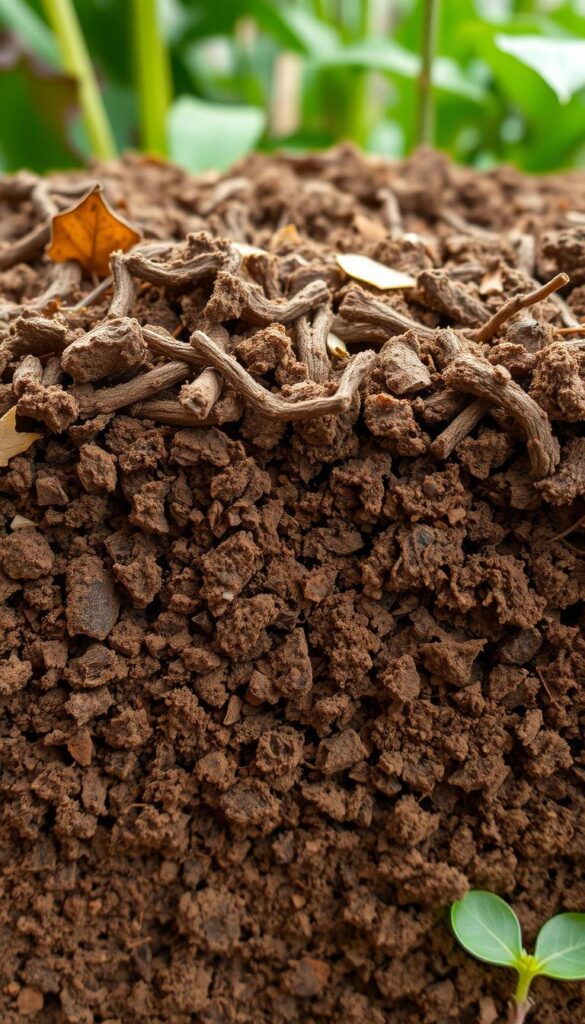
Texture, Drainage, and pH Levels
Three factors determine whether roots thrive or merely survive:
- Gritty balance: Equal parts sand, silt, and clay create loam—the gold standard
- Water movement: Proper drainage prevents root rot while retaining moisture
- Chemical harmony: Most vegetables absorb nutrients best at pH 6.2–6.8
Test texture using the jar method: layer samples with water, shake vigorously, and measure settled layers after 24 hours. Clay-heavy blends benefit from added compost, while sandy types need peat moss. “Aim for 40% mineral content and 5% organic matter,” advises the University of Maryland Extension.
| Texture Type | Drainage Speed | Ideal For |
|---|---|---|
| Clay | Slow | Moisture-loving plants |
| Sand | Fast | Root crops |
| Loam | Moderate | Most vegetables |
pH test kits ($12–$20) reveal acidity levels. Sprinkle agricultural lime to raise pH or sulfur to lower it. Topsoil forms the mineral backbone, while decomposed leaves and compost feed microbial armies. Together, they create air channels that let roots breathe and expand.
Seasonal changes affect performance. Spring rains compact clay-heavy blends, while summer heat bakes sandy types. Annual amendments maintain structure—spread 2 inches of compost each fall. Your plants will reward you with vigorous growth and pest resistance.
Benefits of Using the Right Soil in Your Garden Bed
What if your plants could talk? They’d likely thank you for giving them a premium growing environment. Choosing the correct blend isn’t just about immediate results—it’s an investment in your green space’s future.
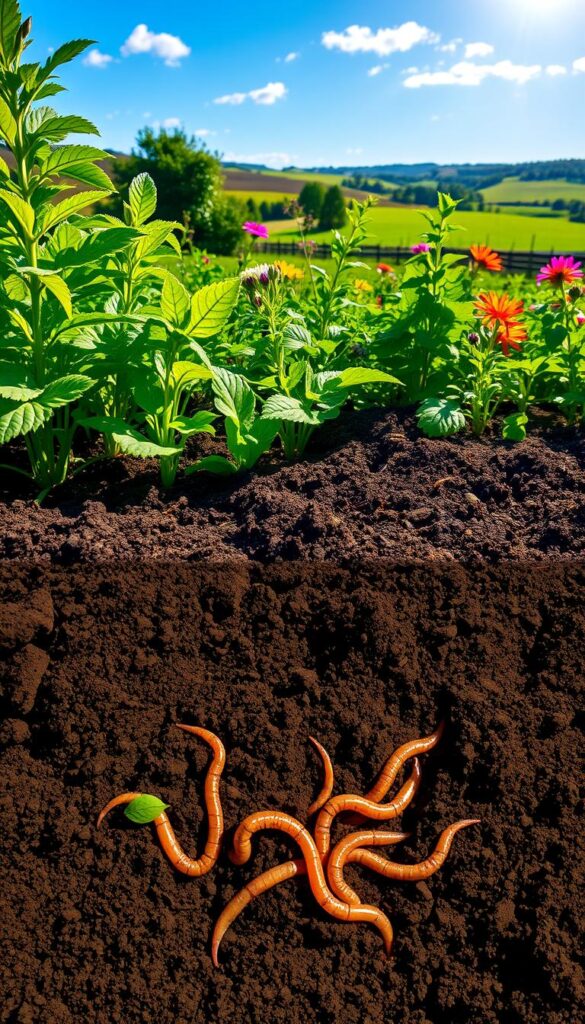
A balanced mix acts like a 24/7 buffet for roots. It holds moisture during droughts yet drains quickly after storms. This balance means fewer cracked tomatoes from uneven watering and no wilted lettuce in summer heat.
See the difference in these results:
| Feature | Raised Beds | In-Ground |
|---|---|---|
| Average Yield | +35% | Baseline |
| Weed Pressure | Low | High |
| Water Use | Efficient | Wasteful |
Rich organic matter feeds microbes that fight diseases naturally. One study showed compost-enriched blends reduced aphid infestations by 40%. You’ll spend less time pulling weeds and more time harvesting.
Over seasons, quality mixes improve themselves. Earthworms aerate the layers, while decomposed leaves add free nutrients. Your initial effort pays off with bigger harvests and fewer replacements needed.
Think long-term: proper preparation now means years of vibrant blooms and crisp vegetables. Your back will thank you too—less bending to deal with pests or replace struggling plants.
How to Choose the Right Soil for Garden Bed
Ever stood in a nursery staring at endless bagged products? Selecting materials for raised beds requires strategy. Start by understanding your existing conditions through testing—this reveals what your plants truly need.
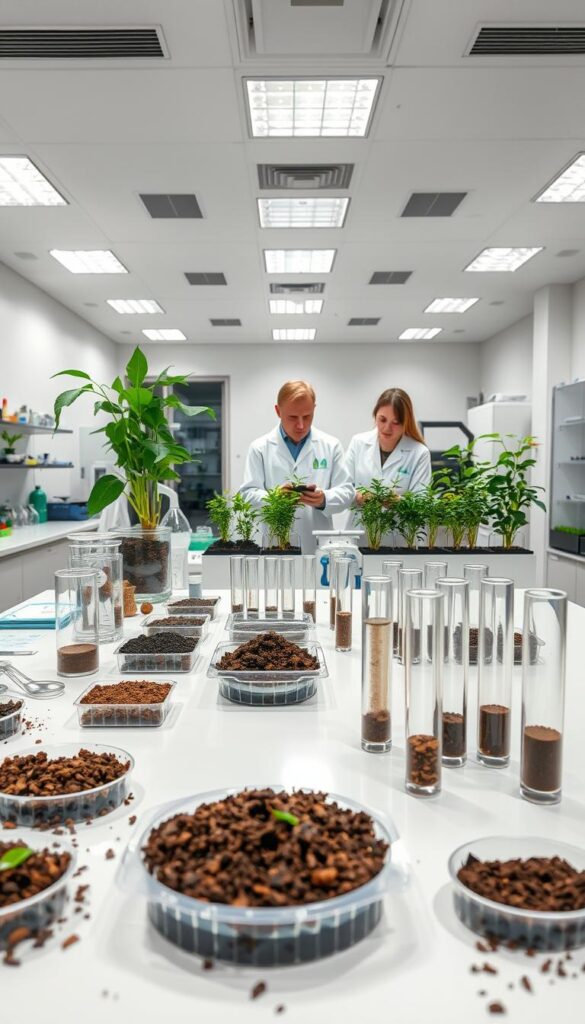
Soil Analysis and Testing Procedures
Grab a trowel and collect samples from 6-8 spots in your planting area. Mix them in a clean bucket—this creates an average profile. Extension services recommend dividing this blend into two parts:
- Use half for DIY tests: Check pH with vinegar/baking soda reactions
- Send the rest to certified labs for nutrient analysis
Professional testing uncovers hidden issues like salt buildup or micronutrient gaps. Penn State researchers found 68% of home test kits misread phosphorus levels. Always request organic matter percentage reports—this determines compost needs.
| Method | Cost | Accuracy |
|---|---|---|
| DIY Kits | $15–$30 | Basic pH/NPK |
| Lab Analysis | $50–$100 | Full mineral breakdown |
Local Versus Bulk-Purchased Options
Compare suppliers using three criteria: source transparency, texture consistency, and amendment history. Local topsoil often matches regional pH but may contain weed seeds. Bulk products save money but require storage space.
| Factor | Local Suppliers | Bulk Retailers |
|---|---|---|
| Cost per cubic yard | $30–$50 | $20–$40 |
| Quality Control | Variable | Certified mixes |
Ask vendors for recent test results. Blend purchased materials with 25% compost to boost microbial activity. Over time, this creates a self-sustaining ecosystem beneath your plants.
Steps for Preparing Your Garden Bed for Soil Success
Creating the ideal environment for plant roots requires thoughtful planning and gentle handling. Rushing through preparation can disrupt delicate ecosystems that take years to develop. Instead, approach your space like a conservationist—preserve what works while enhancing areas needing improvement.
Site Preparation and Minimizing Soil Disturbance
Start by smothering weeds with cardboard or newspaper. This blocks sunlight while decomposing naturally into organic matter. Avoid tilling, which destroys earthworm tunnels and fungal networks essential for nutrient cycling.
Layer 3 inches of compost over the cardboard, followed by 6 inches of topsoil mixed with shredded leaves. This “lasagna” method builds fertility without disrupting existing layers. Pro tip: Use a broadfork to gently aerate compacted areas instead of turning them over.
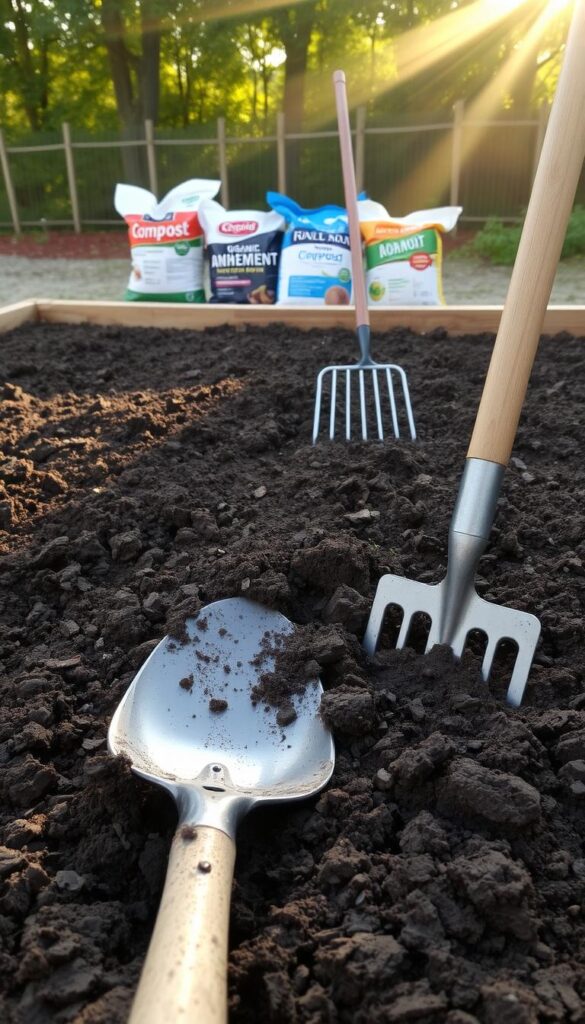
Water lightly to settle materials, then let the site rest for 2-4 weeks. This waiting period allows microorganisms to establish and begin breaking down components. You’ll notice fewer weeds and better moisture retention compared to tilled plots.
| Method | Weed Reduction | Microbe Activity |
|---|---|---|
| Traditional Tilling | 40% | Disrupts colonies |
| No-Till Layering | 85% | Boosts diversity |
When adding amendments, work from boards placed across the surface to avoid compaction. Mix only the top 2-3 inches where seeds will germinate. Deeper layers remain undisturbed, maintaining critical air channels and water pathways.
Over time, this approach creates self-sustaining conditions. Earthworms incorporate organic matter naturally, while plant roots strengthen the structure. Your initial patience pays off with vigorous growth and fewer pest issues down the line.
The Role of Compost and Organic Matter in Garden Soil
What transforms lifeless dirt into a thriving root paradise? Compost acts like nature’s multivitamin, feeding plants while building resilient ecosystems. This decomposed material releases nutrients slowly—nitrogen for leafy growth, phosphorus for roots, and potassium for disease resistance.
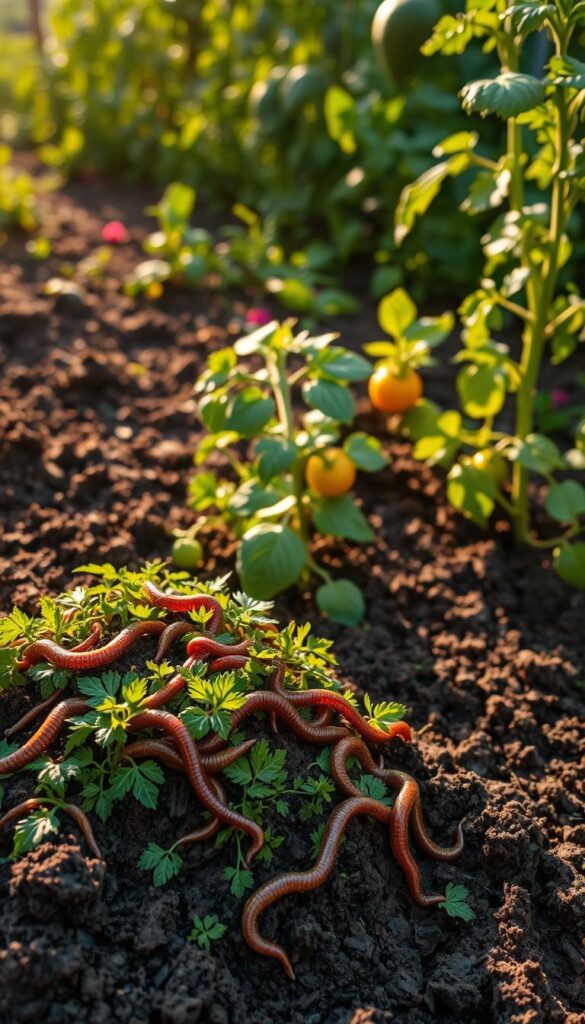
Organic matter improves texture better than any synthetic additive. It binds sandy particles to retain moisture and breaks up clay clumps for better airflow. “One inch of compost can double water-holding capacity,” notes a USDA study. Your plants stay hydrated during heatwaves without drowning in heavy rains.
Compare two scenarios:
| High Organic Matter | Low Organic Matter |
|---|---|
| Earthworms present | Compacted layers |
| 67% fewer pests | Frequent fertilizer needs |
| Self-aerating | Root rot risks |
Sources range from municipal bulk compost to worm castings. Homemade piles using kitchen scraps cost nothing but time. Blend 30% compost with topsoil for raised beds—this ratio prevents nutrient overload while supporting microbes.
Each season, organic amendments rebuild fertility naturally. Beneficial fungi form partnerships with roots, exchanging sugars for minerals. Your harvests grow more abundant as the system matures, proving that healthy foundations yield lasting rewards.
Raised Bed Soil Setup and Management Techniques
How you manage your growing space determines whether roots thrive or merely survive. Strategic approaches preserve microbial networks while maximizing productivity. Let’s explore methods that reduce labor while boosting yields.
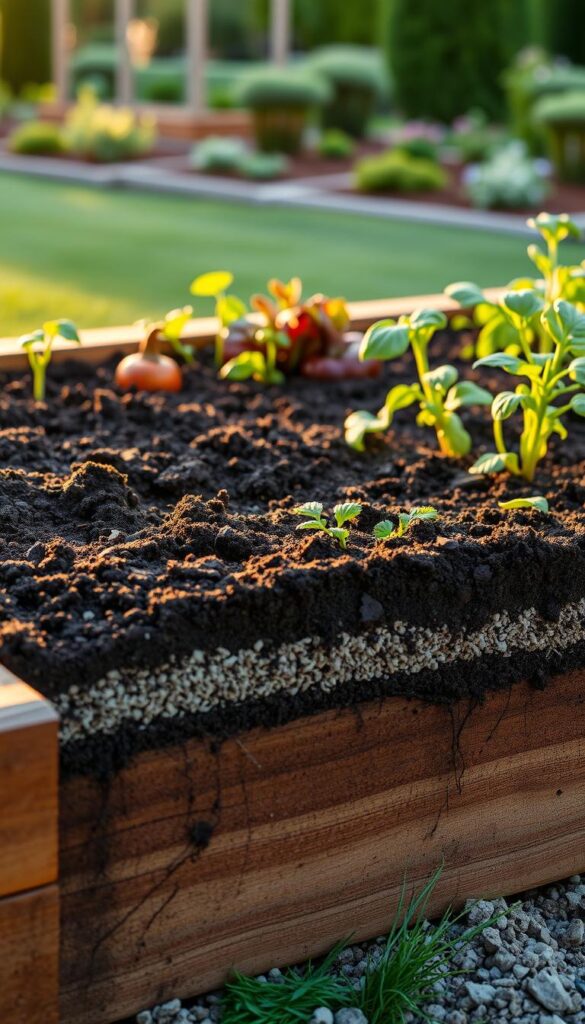
No-Till vs. Minimum-Till Approaches
No-till systems protect fungal highways and earthworm habitats. Simply add 2 inches of compost annually, letting worms incorporate it naturally. Roots penetrate deeper into undisturbed layers, accessing stored moisture during droughts.
Minimum-till methods involve gentle aeration with broadforks. This technique suits clay-heavy mixes needing improved drainage. A 2023 Penn State study found tilled plots required 30% more watering than no-till counterparts.
| Method | Root Depth | Weed Growth |
|---|---|---|
| No-Till | 18+ inches | Low |
| Minimum-Till | 12 inches | Moderate |
Utilizing Pathway Soil for Added Depth
Recycle material from walking paths to build raised beds higher. Screen out debris, then blend equal parts pathway soil and compost. This free resource adds 4-6 inches of planting depth while improving texture.
Follow these steps for resilient mixes:
- Layer 3 inches of aged wood chips under beds for drainage
- Alternate compost and topsoil in 2-inch increments
- Top with bed soil mix containing 25% perlite
Maintain organic matter above 5% using leaf mold or grass clippings. Test clay content annually—ideal blends crumble like moist cake. Your plants will show gratitude through vigorous growth and pest resistance.
Troubleshooting Common Soil Issues in Garden Beds
Are your plants showing strange symptoms despite regular care? Yellow leaves, stunted stems, or standing water often signal deeper problems. Early detection prevents minor issues from becoming major headaches.
- Puddles lasting over 24 hours → Poor drainage
- Cracks forming on surface → High clay content
- White crusts on beds → Salt buildup from low-quality compost
University extensions recommend these fixes for frequent problems:
| Issue | Test Method | Solution |
|---|---|---|
| Compaction | Probe with screwdriver | Mix in perlite + compost |
| Low nutrients | Leaf color analysis | Add worm castings |
| pH imbalance | Lab test kit | Apply lime or sulfur |
Improve heavy clay by adding 3 inches of organic matter annually. For sandy mixes that drain too fast, layer peat moss beneath topsoil. Always screen compost for debris before use—contaminated batches introduce weeds.
Check moisture with a simple finger test: dig 6 inches down. If it feels Sahara-dry or swamp-wet, adjust watering habits. Mulch with straw to stabilize conditions and feed earthworms.
Regular testing every spring tracks progress. Healthy roots mean happy plants—and ultimately, bountiful harvests.
Lessons from Raised Bed Soil Experiments and Trials
After a year of rigorous testing, one blend consistently outperformed others—producing 42% more tomatoes than standard mixes. Researchers tracked plant health, yield, and resilience across various combinations to identify what truly works.
Insights from Mel’s Mix
Mel’s Mix—a combination of equal parts peat moss, compost, and vermiculite—excelled in heavy rainfall regions. Its secret? The blend creates air pockets that prevent waterlogging while retaining essential moisture. Broccoli grown in this mix developed 30% larger heads compared to native blends.
| Component | Function | Impact |
|---|---|---|
| Peat Moss | Moisture control | Reduces compaction |
| Compost | Nutrient release | Boosts microbial activity |
| Vermiculite | Aeration | Enhances root growth |
Comparing Bagged Soil Mix and Native Soil
Bagged products showed mixed results. While convenient, some lacked organic matter diversity—leading to “feast-or-famine” nutrient cycles. Native blends amended with compost matched yields in 8 out of 10 crops but required monthly fertilization.
| Factor | Bagged Mix | Native Blend |
|---|---|---|
| Tomato Yield | 18 lbs/plant | 12 lbs/plant |
| Cost per Season | $65 | $28 |
| Weed Growth | Low | Moderate-High |
Trials revealed a critical lesson: balance matters more than individual ingredients. Plants thrived when peat moss moderated drainage, compost fed microbial networks, and mineral bases provided structure. Your best bet? Start with tested recipes like Mel’s Mix, then adapt based on local conditions.
Monitoring Soil Health and Amendments
Regular check-ups aren’t just for people—your growing medium needs them too. Annual testing reveals hidden issues like nutrient gaps or pH swings. Extension services recommend sending samples to certified labs every spring. “Think of it as a wellness exam for your planting zones,” advises a Cornell University specialist.
- Earthworms tunneling through layers
- Quick water absorption without pooling
- Crumbly texture that holds shape briefly
Adjustments should follow test results. Low nitrogen? Mix in aged manure. High acidity? Sprinkle wood ash. A 2023 study showed adding 1 inch of compost boosts microbial activity by 60% in 8 weeks.
| Test Frequency | Amendment | Impact Timeline |
|---|---|---|
| Annual | Compost | 4-6 weeks |
| Biannual | Topsoil | Next season |
| As needed | pH balancers | 2-3 months |
Track changes with a simple journal. Note watering patterns, plant vigor, and harvest weights. Over time, these records reveal what your mix truly needs. Small tweaks—like adding perlite for drainage—often yield dramatic growth improvements.
Consistent care prevents big problems. Healthy systems resist pests naturally and recover faster from extreme weather. Your efforts today ensure years of abundant harvests tomorrow.
Seasonal Soil Management for Year-Round Garden Success
Think of your growing space as a living calendar—each season demands unique care to sustain vitality. Proactive adjustments protect roots from temperature swings while maintaining nutrient-rich conditions. Timing matters: a well-timed amendment can mean the difference between thriving crops and disappointing yields.
In fall, focus on protection. Spread 2 inches of compost over beds to replenish organic matter. Shred fallen leaves and mix them into the top layer—this creates winter insulation while feeding earthworms. “Cold weather preparation sets the stage for spring’s explosion of growth,” notes a USDA horticulturist.
Winter calls for minimal disturbance. Cover empty areas with straw or clover to prevent erosion. If using raised beds, rotate cover crops like winter rye to anchor nutrients. Check moisture levels monthly—dry winter winds can parch layers faster than you’d expect.
| Season | Key Tasks | Benefits |
|---|---|---|
| Spring | Test pH, add balanced fertilizer | Prepares for planting surge |
| Summer | Mulch with grass clippings | Retains moisture, cools roots |
| Fall | Incorporate leaf mold | Boosts winter resilience |
Spring revitalization starts early. Blend equal parts compost and topsoil to refresh depleted zones. For heavy clay, add perlite—its airy structure prevents waterlogging during April showers. Test nutrient levels every 3 years to fine-tune your mix.
Extreme weather demands quick action. During droughts, water deeply at dawn to minimize evaporation. In rainy spells, elevate beds with wood chips to improve drainage. Consistent care ensures your foundation remains productive through every seasonal shift.
Conclusion
Your dedication to building a strong foundation pays dividends through vibrant blooms and abundant harvests. The right blend of organic matter, topsoil, and compost creates an environment where roots access nutrients while staying protected from extremes.
Regular testing ensures your mix maintains optimal pH and texture. Seasonal amendments—like adding leaf mold in fall—keep raised beds productive year-round. Studies show balanced blends increase yields by 35% compared to untreated plots.
Lessons from field trials reinforce simple truths: quality components matter more than quantity. Earthworms thrive in compost-rich layers, naturally aerating your base. This reduces watering needs and strengthens plants against pests.
Apply these insights to elevate your growing success. Monitor moisture levels, refresh mixes annually, and prioritize long-term health over quick fixes. Investing in your foundation today means enjoying tastier vegetables and heartier flowers tomorrow.
Remember: every thriving garden begins with what lies beneath. Start small, observe results, and let nature reward your efforts.

